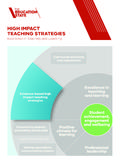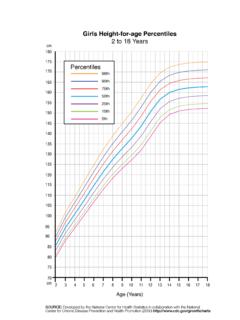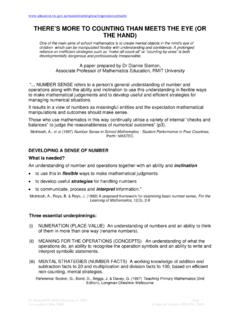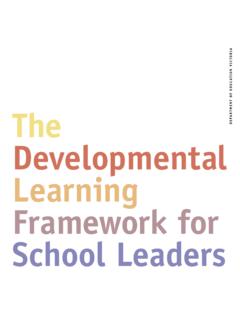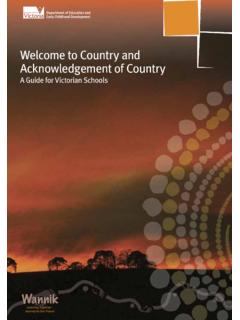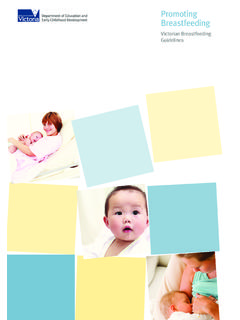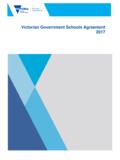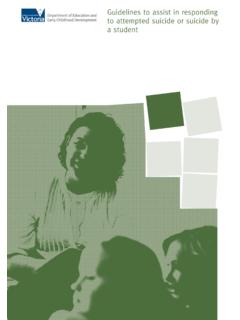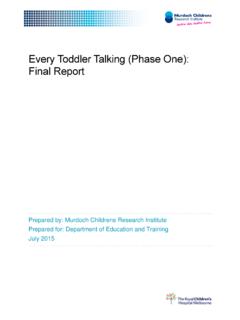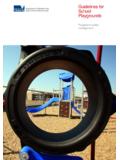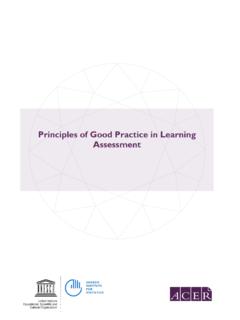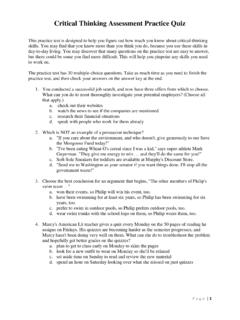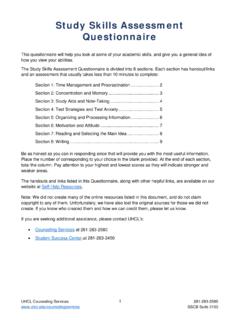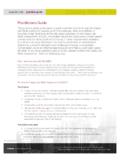Transcription of FORMATIVE ASSESSMENT - education.vic.gov.au
1 Professional Practice Note 6. FORMATIVE ASSESSMENT as a focus for their work with professional learning communities and in each classroom. ASSESSMENT . UNDERSTANDING FORMATIVE ASSESSMENT . FORMATIVE ASSESSMENT provides the feedback to enable The fundamental purpose of ASSESSMENT in education is to establish and understand the points that students (either as teacher and student to answer three key questions: individuals or groups) have reached in their learning at the What is to be learned? time of ASSESSMENT . Masters, (2015)1 How is learning progressing? What will be learned next?3. OVERVIEW. This Professional Practice Note provides guidance for THE PURPOSE OF ASSESSMENT . teachers and school leaders on FORMATIVE ASSESSMENT : what Rather than categorising ASSESSMENT as as learning', for it is and how to build it into regular classroom practice. learning', or of learning', we need to focus on what Used alongside a set of clearly defined and challenging ASSESSMENT tells us about the progress that students learning intentions, FORMATIVE ASSESSMENT is continuous (individually or in groups) have achieved in their learning at feedback that allows a teacher to evaluate impact and a the time of ASSESSMENT .
2 Student to move their learning forward2. We can start to see all ASSESSMENT in schools as FORMATIVE if If we understand ASSESSMENT as the process of establishing we focus on the question what is the purpose of the where students are at then, in fact, all ASSESSMENT is ASSESSMENT ? A form of ASSESSMENT traditionally FORMATIVE . Incorporated into a teaching and learning cycle, understood as summative', such as a test, can be FORMATIVE FORMATIVE ASSESSMENT is at the heart of improving student if the teacher uses what they learn from the students' test learning outcomes. results to modify a lesson plan to revisit a topic previously covered4 because they identify gaps in their students'. FORMATIVE ASSESSMENT provides the answers to the understanding. questions: Is learning on track? What needs to change? Where does learning go next? It can be immediate (a Similarly, a diagnostic' ASSESSMENT focusing on alphabet specific question, thumbs up-thumbs down) or planned (a recognition becomes FORMATIVE when the teacher uses the quiz, a student moderation).
3 It is timely (built into every data gathered to build in explicit teaching5 on phonemic lesson of every unit), and iterative (closes the circle of awareness for their Foundation class. planning). The information that FORMATIVE ASSESSMENT yields can be This Professional Practice Note, together with Practice used in many different ways: to define learning intentions, to Principles 1: High Expectations, 4: Curriculum Planning, and design a unit of work based on the Victorian Curriculum, to 6: Rigorous ASSESSMENT practices , provide a reference identify gaps or misconceptions in individual understanding, point for future planning and improvement and can support to identify a student's zone of proximal development, or to teachers and school teams to use effective FORMATIVE 1. Masters, G (2015) Rethinking FORMATIVE and summative 4 See High Impact Teaching Strategy 6: Multiple Exposures: DET . ASSESSMENT ' Teacher, ACER. Retrieved 27 February 2018: High Impact Teaching Strategies (HITS): masters/rethinking- FORMATIVE -and-summati ve- ASSESSMENT s/practice/improve/ 2 Wiliam, D (2011), Embedded FORMATIVE ASSESSMENT .
4 Victoria: 5 See High Impact Teaching Strategy 3: Worked Examples and 10: Hawker Brownlow Education, Differentiated Teaching, HITS ( ). 3 Hattie, J (2003). FORMATIVE and Summative Interpretations of ASSESSMENT Information: who says FORMATIVE ASSESSMENT matters, Professional Practice Note 6. inform the cycle of teaching and feedback in the classroom. For FORMATIVE ASSESSMENT to be used well it is essential that: FORMATIVE ASSESSMENT IN CONTEXT. learning intentions, Victorian Curriculum F-10. FORMATIVE ASSESSMENT can be used alongside data walls10. achievement standards, and forms of ASSESSMENT are in that it provides teachers with evidence of student closely linked learning. Both FORMATIVE ASSESSMENT and data walls feed the learning program is designed to scaffold and stretch into the design of learning and actionable classroom students, enabling them to achieve their goals6 strategies and build collective efficacy that is, teachers'.
5 Collective power to improve learning outcomes for students. the learning program is differentiated it is built and modified around the individual learning needs of the Peer observation11 also has a key role to play FORMATIVE ASSESSMENT as it enables teachers to build individual capability and develop a shared understanding of effective practice. Peer observation is also incorporated into a FORMATIVE ASSESSMENT IN SCHOOLS. learning cycle, based on feedback and built on explicit Schools where teachers collaborate, adopt evidence-based criteria. teaching strategies, have professional conversations about how to improve their teaching, and use evidence to moderate ASSESSMENT are all using FORMATIVE ASSESSMENT . USING FORMATIVE ASSESSMENT . Evidence must be directly observable (the teacher should The purpose of FORMATIVE ASSESSMENT is to provide feedback be able to see it, touch it or hear it8). It provides the for learning. This can be: qualitative and quantitative data to inform both the teacher and the learner about progress.
6 It should be linked to the feedback to the teacher about how and where to modify Victorian Curriculum F-10 achievement standards. the teaching program to meet the needs of one or more of their students Examples of FORMATIVE ASSESSMENT techniques include: hot- seat questioning, all-student response and question shells9. feedback on what achievement of standards looks like All of these are designed to provide the teacher with diagnostic feedback incorporated into the design of a evidence of the impact of their teaching on their student's learning program with learning outcomes in mind (or learning. A teacher can then use this to guide the lesson backward mapped12). design and pace, select different strategies, differentiate, and give feedback to individual students. Good feedback To put this into practice, let's look at examples of four enables students to move their own learning forward. strategies of FORMATIVE assessment13 in an improvement cycle process.
7 Using multiple forms of FORMATIVE ASSESSMENT in a classroom strengthens ASSESSMENT practice overall. It provides the structure and process for teachers and To clarify learning intentions students to develop a shared and deep understanding of One week into a four week unit of work on persuasive learning intentions, success criteria and the curriculum writing skills, a Year 3 teacher sets a writing prompt and standards on which ASSESSMENT is based. collects their students' work. Working from a rubric, they identify that most of the students are able to organise their 6 See High Impact Teaching Strategy 10 Differentiated Teaching, 10 DET Professional Practice Note 6 Using Data Walls: HITS ( ) 7 Practice Principle 1: High Expectations - DET - Practice 11 DET Professional Practice Note 4 Peer Observation, Principles: Feedback and Reflection: s/practice/improve/ 8 Griffin, P (2009), ASSESSMENT is for teaching' Independence, 34, practice/ No 2, 12.
8 Wiggins, G. & McTighe, J. (2005). Understanding by Design . 9 Wiliam, D (2011), (op. cit), Expanded 2nd Edition. Alexandria, VA: ASCD. 13 Wiliam, D (2011), (op. cit), Professional Practice Note 6. ideas and communicate effectively, but that many have understanding of the learning intentions and success made errors of punctuation, spelling, and grammar. The criteria16. teacher decides to revisit the learning intentions and build in These examples show how teachers can use FORMATIVE explicit teaching on re-reading, editing and checking for ASSESSMENT to prepare a student learning program and vocabulary, structure and meaning. make adjustments as needed. In each case, the ASSESSMENT practice is firmly based in planned learning To analyse evidence of student learning intentions based on explicit curriculum-linked ASSESSMENT Prior to starting a unit of work, a Year 7 teacher designs a criteria. short test to evaluate their students' understanding of rational number.
9 The results show that several students have misconceptions in their understandings of fractions ENABLERS OF SUCCESSFUL FORMATIVE . and decimals. As a result, the teacher uses the Victorian ASSESSMENT . Curriculum F-10 achievement standards to revisit the Strong FORMATIVE ASSESSMENT practices are enabled when: learning objectives and selects a different instructional focus and teaching strategy for her students. teachers have a deep understanding of the curriculum, and the continuum of student learning To provide feedback to improve learning teachers have high expectations of their students and Year 9 students working on media texts are invited to write design and modify the learning program as part of a and present their own sample of Fake News'. A rubric is continual process based on the feedback it provides17. shared with the students, which they discuss as a group. teachers use differentiated teaching to select strategies Their teacher explains that they will use a rubric to assess to extend the knowledge and skills of every student in each other's work, and give feedback to each other based every class, regardless of their starting point18.
10 On the criteria identified in the rubric. They also put dots in the margins of each line that needs attention, and then teacher practice is based on a deep understanding of return the written pieces to the original authors for reflection the purpose of ASSESSMENT and and further development. The teacher is using feedback that causes thinking and moves learning forward14. ADVICE FOR SCHOOL LEADERS. A key point about FORMATIVE ASSESSMENT is the role it plays To enable learners to learn from each other in enabling powerful professional conversations about A Year 5 teacher teaching a unit on creative writing selects impact on teaching. School cultures that invite challenging an instructional focus on creating fantasy characters. After conversations invite teachers to work in teams and develop a period of explicit teaching15 on how language features, shared ownership of the strategies and solutions they use. and vocabulary influence interpretations of characters, Schools with deeply embedded practices of FORMATIVE settings and events, their teacher sets up a student ASSESSMENT are likely to have a strong culture of open, moderation.
